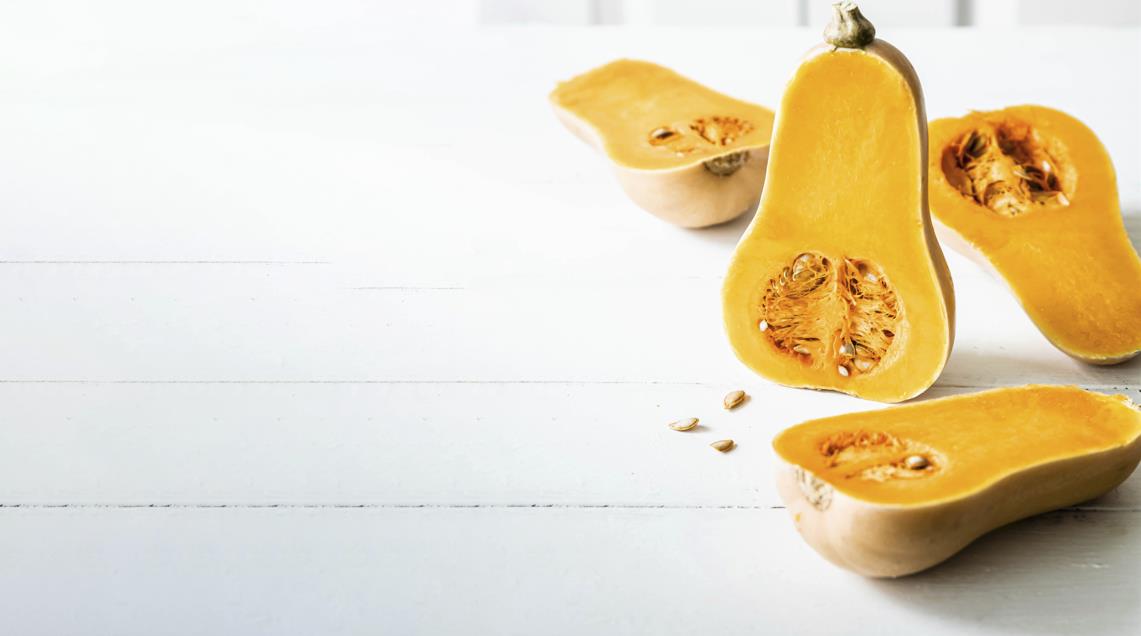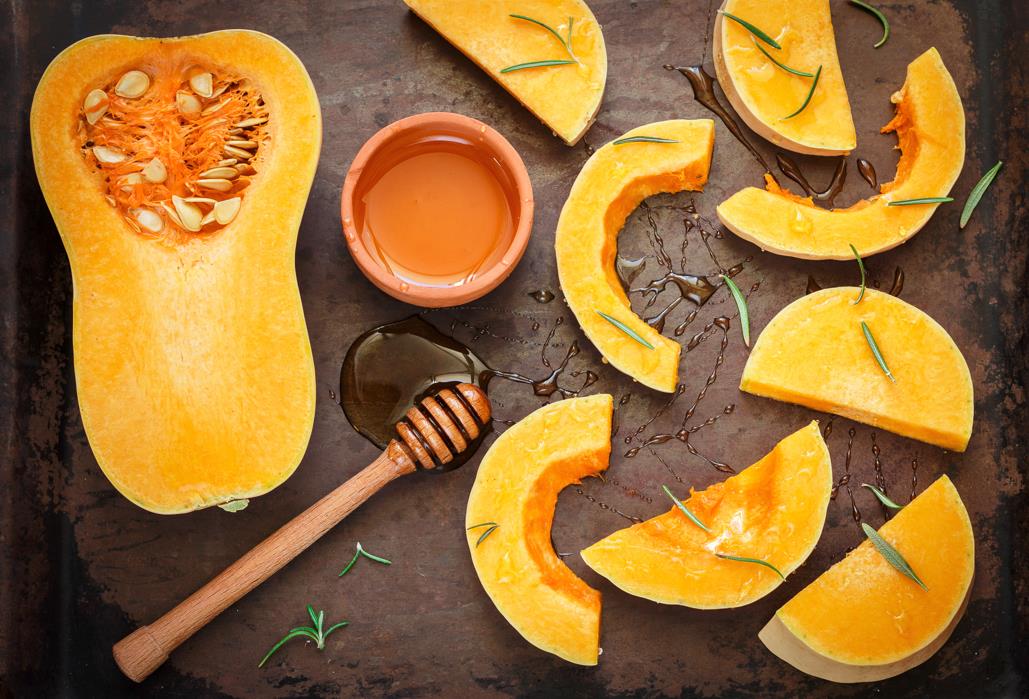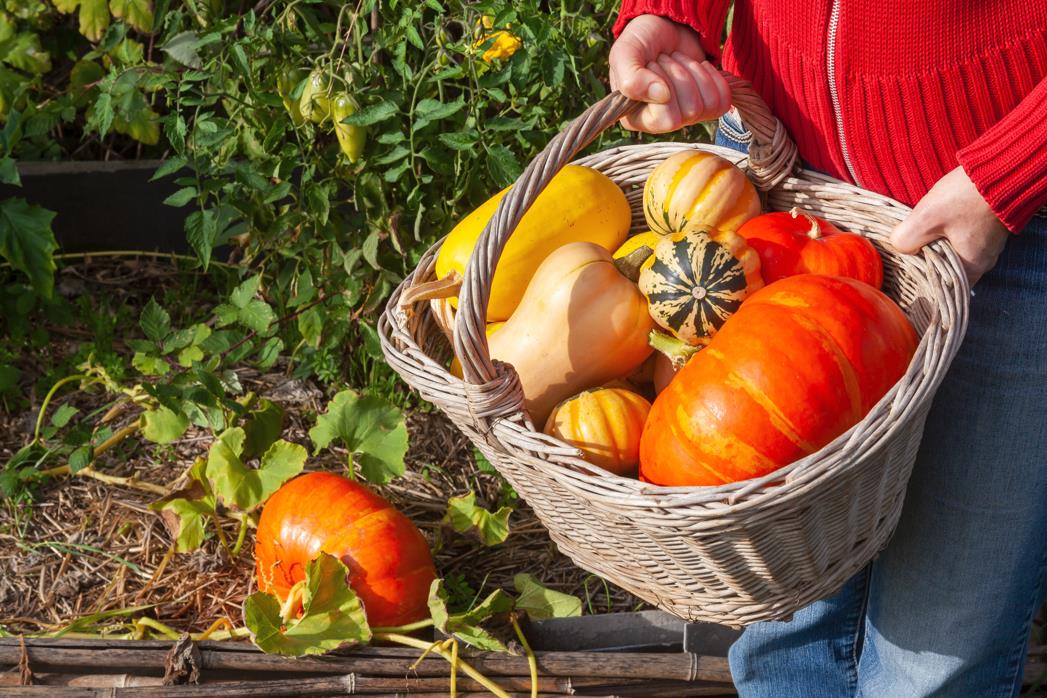Butternut squash delights in the kitchen with its sweetly comforting flavor and brightly hued cheerfulness.
We want you to get the most out of butternut squash and in this article, we’re going to look at prepping it, cutting it, storing it, and see how it stacks up alongside its relative the pumpkin.
We’ll include other cool info too so let’s get cracking!
Table of contents
Cutting butternut squash
Butternut squash can be slightly daunting in the kitchen if you buy it whole. It’s large, bulky and has a skin like a rhinoceros! We’re here to dispel any confusion for you.
Removing the peel from butternut squash
As a first step let’s look at peeling a butternut squash. Note, this is an optional step when cooking butternut. The peel has loads of nutrients, it’s good for fiber intake and can be cooked until soft enough to eat – but if you don’t like the peel, here’s how to remove it:
Method 1
Butternut squash can be peeled whole with a good quality, durable peeler. You’ll need a tough peeling tool to cope with that thick butternut rind! We recommend a metal peeler, not a plastic one as it may break or bend if you try to use it on butternut squash.
Method 2
Alternatively, you can use a sharp chef’s knife to cut through the butternut horizontally, so that you have two halves of butternut. Now place a half of butternut face down (skin side up) on your chopping board, and holding it firmly, carefully remove the skin with your chef’s knife, peeling it off in vertical strips.
Method 3
Cut both ends off the butternut with your sharp chef’s knife, about an inch from either end, removing both the stem and the base. Now place the butternut squash in a microwave safe dish and microwave on high for 4 minutes.
This will soften and loosen the skin, and you can either use a peeler or knife to continue removing the skin entirely, or just work it off carefully with your fingers. Remember, wait until the butternut is cool enough to handle!
Deseeding butternut squash

Once you’ve disjointed a butternut squash and cut it into a more manageable shape and size, deseeding it is relatively easy.
- Using your sharp chef’s knife, remove both ends of the butternut, cutting off about an inch on either side, both stem and base. This will give you two flat surfaces to balance the butternut on.
- Now cut down the butternut vertically, straight through the middle. Either hold the butternut firmly in a vertical position with your non – cutting hand or hold it firmly on a chopping board as you cut through it. This will give you two halves of butternut.
- Once the butternut is halved the seed cavities will be easily visible and you can take a metal spoon and scoop out the seeds and pith matter. Either discard this or rinse and dry the seeds to be roasted later as a snack.
Cutting butternut squash into cubes
What you’ll need:
- Butternut squash
- Sharp chef’s knife
- Chopping board
- Bowl or dish to put cut butternut into
Handpicked for you
True cutting power in the palm of your hand
- Once you’ve followed our prepping instructions and your butternut squash is both deseeded and peeled, simply place your halved butternut squash flat side down on your chopping board lengthways.
- Using your chef’s knife, cut through each half of the butternut horizontally. Hold it carefully in place with your non – knife hand.
- Once you’ve cut horizontally through the butternut half, secure those two halves together with your non – knife hand and proceed to cut vertically along them. The wider apart your vertical cuts are, the larger your cubes or chunks of butternut will be.
- If you want smaller cubes of butternut, cut each butternut half horizontally twice, then proceed with cutting along those pieces vertically to get cubes.
- As you work, scoop up the ready cubes and put them into a bowl or dish to keep your work surface clear.
Cutting butternut squash into slices

Perhaps you want slices of butternut for roasting or to use in a stir fry? That’s easily done –
Place a peeled and deseeded half of butternut flat side down on your chopping board. Put it vertically so that it’s standing longways in front of you.
Holding one side firmly with your non – cutting hand, slice through the butternut half from top to bottom vertically in increments. Wide apart for thick slices, and cuts closer together for thin slices.
Remember, butternut when cooked softens quite dramatically, so keep the slices quite chunky so that it preserves its shape during the cooking process!
Storing butternut squash
Whole butternut squash with the skin on does best stored in a cool, dry environment like a cupboard or dry cellar. If the skin isn’t broken or damaged, this is the best option for storing it as putting it into the fridge will introduce moisture, which reduces its shelf life.
If the butternut is cut into pieces, it’s best to store it in the refrigerator in an airtight container. In the refrigerator it will keep fresh for about a week. If you want it to stay fresher in the fridge for longer, wrap the individual pieces of butternut in cling wrap before putting them into the airtight container.
Health benefits of butternut squash
- Butternut squash is low in fat
- Butternut squash contains powerful minerals like potassium and manganese to support health
- Butternut squash is high in fiber particularly when eaten unskinned – this is critical to digestion and tummy health
Butternut squash vs pumpkin – what’s the diff?

Butternut squash and pumpkin are closely related, they’re fam. Both vegetables are squashes. How do they compare though?
- Butternut squash has a tubular, elongated shape. Pumpkins on the other hand are usually round or oval in shape
- Mind blowing factoid – both butternuts and pumpkins are considered FRUITS because they have the seeds on the inside!
- Butternut squash is available throughout the year. Pumpkin is only available September until November
- Pumpkins are lower in calories and carbohydrates than butternut squashes, but both are healthy to eat and full of vitamins and minerals that foster good body function
- Both butternut squash and pumpkin can be used in both sweet and savory recipes, and both can be baked. Because it can have a very tough outer skin though, it’s advisable to bake pumpkin whole instead of trying to saw through it raw. Once baked or roasted the pumpkin skin is far softer and thus easier to handle
Butternut squash FAQs
How do I buy a good quality, fresh butternut at the grocers?
Look out for butternuts with a matte skin that isn’t wrinkled, cracked, or spotted. A good butternut will be heavy relative to its size and the skin should be so firm that you can’t pierce it with your fingernail. This means that the butternut was ripened properly.
What parts of the butternut are safe to eat?
Every part of the butternut is safe to eat – peel, seeds, pith, and the flesh itself. The peel and seeds particularly are rich in fiber and thus good at cleansing your digestive tract of impurities.
Should I avoid butternut squash if I’m on a low – carb eating plan?
Yes. Butternut is a starchy vegetable and contains bad carbs, so don’t eat it if your diet plan or doctor indicates that it won’t be good for you, or your weight loss goals.
In conclusion
Butternut squash has a lot to offer both in nutrients and gloriously sweet flavor. This article on prepping, cutting, storing, and eating butternut squash as part of a healthful diet has hopefully inspired you to reach for this golden vegetable friend the next time you’re shopping for your veggies!
Do search this site for other veggie related articles – veggies are the building blocks of good nutrition and we’ve got some fabulous articles on how to use them effectively in your home kitchen, as well as one-and-only cutting tools to aid in your food preparations!












